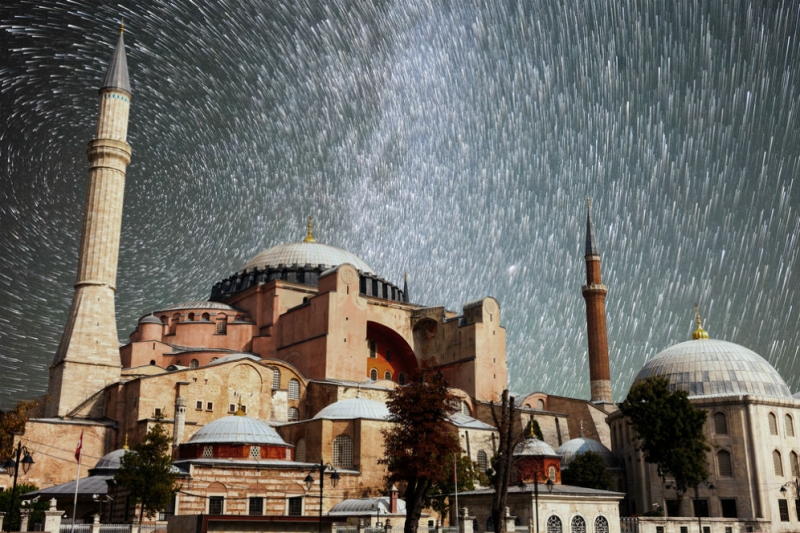
The Hagia Sophia has been towering over Constantinople, now Istanbul, for almost one and a half thousand years. It began to be built in 532, when the Byzantine Emperor Justinian I ordered the reconstruction of the temple on the site of the basilica that burned down during the Nika uprising.
The name of the temple is not connected with a woman, as it might seem, Hagia Sophia is simply translated from Greek as “Holy Wisdom”. The construction of the cathedral was completed in just 5 years. If you believe the historical chronicles, then 10 thousand people worked on the site at the same time, and the total cost of the temple exceeded 3 annual budgets of the Byzantine Empire.

Why such spending? It’s all the fault of the emperor’s will. According to legend, on the day of the consecration of the temple, Justinian entered the cathedral with the words “Solomon, I have surpassed you!” It was fundamentally important for the emperor to create a masterpiece larger than the legendary Temple of Jerusalem. And Justinian succeeded. The dome of the building reached 55 meters. Its diameter was 31 meters. Hagia Sophia became the largest temple in the world and retained this title until the construction of St. Peter’s Basilica in Rome.
Separate parts of ancient buildings were brought to Constantinople to decorate the temple. For example, 8 old marble columns were brought from Ephesus and Rome. The altar inside the cathedral was richly decorated with gold, precious stones and pearls. The dome of the temple seemed to float in the air. Streams of light entered the room through 40 huge windows.


Hagia Sophia was a Christian temple until the middle of the 15th century, when the troops of Sultan Mehmed II took Constantinople. The invaders ruthlessly destroyed most of the churches, but the majestic cathedral survived. The cross on the dome was replaced by an Islamic crescent. Two minarets were added to the building. Later, two more were added and all the minarets were strengthened with stone buttresses, which have survived to this day. Over the years, several tombs were added to the cathedral for the burial of sultans. Christian frescoes and mosaics depicting worshipers praying were covered with plaster. Fortunately, today it was possible to remove it. Visitors to the cathedral can once again admire magnificent examples of Byzantine painting.

The history of the cathedral is associated with a number of legends. Let’s list some of them.
On a column in one of the premises of the temple, at a height of more than two meters, a trace resembling the imprint of a human palm is visible. According to legend, Sultan Mehmed, who captured the city, left it, leaning his hand on the column. The Sultan rode on horseback over the corpses of defeated Christians, which is why the print turned out so high from the floor.
On the right side of the temple there is a niche of unknown origin; If you put your ear to the wall, you can clearly hear the noise. According to legend, during the storming of the cathedral by Mehmed’s troops, 10 thousand people were hiding there. They were led by a priest holding a chalice with the Holy Gifts in his hands. Suddenly, while reading a prayer, he walked to the niche and disappeared without a trace. They say that the quiet sound from the niche is the continuation of the priest’s prayer. He prays and waits for the cathedral to be returned to Christians. At the moment when the cross rises over Hagia Sophia again, the holy father will return to the altar and continue the interrupted service.

During the reign of Turkey’s first president, Mustafa Ataturk, in 1935, the Hagia Sophia Mosque was converted into a museum. During the inspection of the cathedral, tightly boarded up doors were found. They did not open them because they were afraid of the release of groundwater, the level of which is very high here and cannot be reduced. In recent years, archaeological scientists have found several secret passages and tunnels allegedly connecting the Hagia Sophia building with the Topkapi Palace, the main residence of the Ottoman padishahs. Now the palace building houses a museum. Its collection includes more than 65 thousand exhibits: from porcelain dishes, silverware and personal belongings of the rulers of the Ottoman Empire to a golden throne and a staff that allegedly belonged to Moses.

In 2013, the Turkish Parliament discussed the feasibility of transferring the Hagia Sophia Museum to the status of a functioning mosque, but Patriarch Bartholomew I of Constantinople opposed it. He noted that then it would be fairer to return the church to Christians, but it would be better to avoid conflict and maintain its status. The Christian population of Istanbul supported the patriarch, and Hagia Sophia remained a museum.
Getting to Istanbul from Russia is easy. The cost of air tickets for direct flights starts from 5 thousand rubles. You can visit the Hagia Sophia from 9 a.m. to 5 p.m. In summer the museum is open until 19 pm. The day off is Monday, and the museum is also closed during the Muslim holy holiday of Ramadan. The entrance ticket costs 10 euros. You can get to the cathedral by ground public transport or by metro to Sultanahmet station. If you want to visit the main museums of Istanbul on preferential terms and without waiting in line, buy the Museum Pass Istanbul. It seriously makes life easier for tourists.
For convenient and profitable booking of hotels around the world, we recommend using the OneTwoTrip service. There you will find more than two million accommodation properties.

